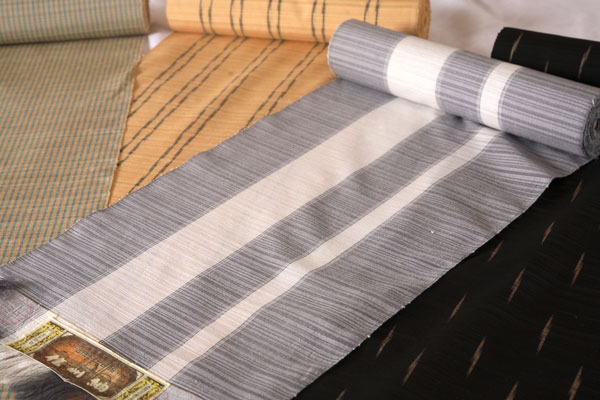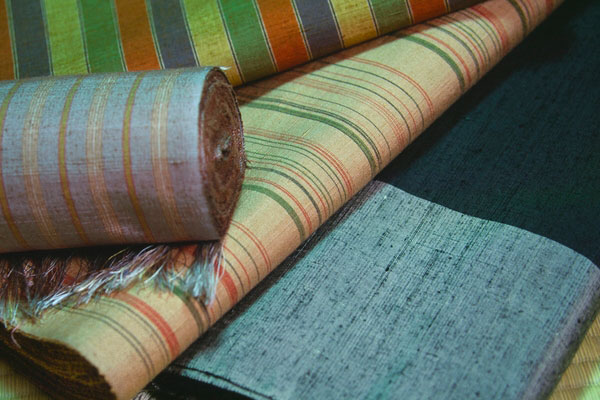 Photo:Shinshu・Nagano Prefecture Tourism Association
Photo:Shinshu・Nagano Prefecture Tourism Association
- Woven textiles
- Nagano
Shinshu tsumugi silk Shinshu tsumugi
Hand drawn and spun, hand dyed and woven
Natural textiles of great beauty and elegance
Description
What is Shinshu tsumugi silk ?
Shinshu tsumugi is a type of silk fabric also known as pongee and produced throughout Nagano prefecture. Each region in the prefecture has their own production styles and techniques. Also, the specific name of this fabric differs depending on the region such as Matsumoto tsumugi, Ueda tsumugi,Ina tsumugi and Yamamayu tsumugi, and being produced over such a wide area, each kind of Shinshu tsumugi has its own unique character. This craft is known for superb color dyeing and quietly restrained silk sheen. The raw materials are hand-spun threads from raw silk, wild silk, dupioni silk, and floss silk. The traditional dyeing techniques are centuries-old and use natural plant dyes. This is a delicate method where the same shades can never be created twice. Pongee is either plain or a pattern weave, with the main patterns being stripes, checks, and splashes. Since every roll of kimono cloth is hand-woven from dyed threads, no two pieces with the same pattern will ever be identical. Hand weaving gives warmth, simplicity, and adds distinctive texture to the fabric. Sometimes the naturally green cocoons of Japanese oak silkmoths are used as raw material. Wild oak silk kimonos are so lightweight yet durable, that they are passed down multiple generations.
History
 Photo:Shinshu・Nagano Prefecture Tourism Association
Photo:Shinshu・Nagano Prefecture Tourism Association
The origins of Shinshu tsumugi is said to beashiginu silk cloth woven in the Nara period (710-794). Since ancient times, the Shinshu region was known as the "silkworm province" due to its thriving sericulture. Early in the Edo period (1603-1868), the Shinshu government financially backed sericulture and the production of woven fabric started to become a side business for farmers. Using threads hand-spun from raw or floss silk, the weaving of pongee began, and within a short time the entire region flourished as a pongee production center. Every year large quantities of pongee were exported to Kyoto and, due to its ideal climate and an abundance of plants, Shinshu became a mainstay of plant dyeing. Although kimono textile production had declined partly due to the popularity of Western style clothing by the middle of the Showa period (1926-1989), the techniques of Shinshu tsumugi were maintained in the region. After World War II, Nagano prefecture implemented successful measures to support and promote the pongee textile industry, and the production of Shinshu tsumugi flourished again throughout the entire prefecture. Today, Shinshu tsumugi has a well-earned reputation as a luxury kimono textile that is produced through an integrated system covering every aspect from cocoon spinning through to the final woven fabric.
General Production Process
- 1. Cocoons
For a very long time, cocoon cooking and degumming of raw silk has been done with straw-ash supernatent and filtrate lye. Degumming is a process that removes sericin, a water-soluble protein which sticks the cocoon threads together. The use of lye enables the potassium or other minerals in straw ash to attach onto the fibers. This gives an elegant sheen, resilience, and improves the texture of pongee to make a beautiful rustling sound.
- 2. Making floss silk
Floss silk is made by boiling cocoons for several hours and opening each one by hand to make a bag shape. Also, the cocoon is stretched over a wooden frame to make floss silk squares. The quality of the silk is determined by the selection and combination of cocoons while the quality of hand-spun threads depends on the finished condition of the floss silk. Floss silk made from fresh cocoons is elastic and thought to be the best for floss silk pongee.
- 3. Hand-spinning
Fibers are pulled by hand from floss silk and spun threads are wound around a flyer type hand spinning machine. Since the thread is barely twisted, the finish is similar to an entirely hand-spun thread. Hand-spun threads have an uneven thickness, which gives the spun thread individuality. Wild silk threads made from natural cocoons is so valuable, that it is known as the queen of fibers.
- 4. Dyeing
The threads are simmered in natural liquid dye made from seasonally harvested trees, plants, nuts, or fruits. The use of natural plants means the dyeing process aligns with the seasons. The dyeing and drying process is done many times to deepen and darken the hues, using the same dye repeatedly. The colors may also be blended by adding different dyes which requires the artisan's dyeing skills as well as good taste.
Unlike other production areas, the Shinshu region has no professional dyeing factories so the dyeing process is done at individual textile factories or workshops by dyers using the traditional techniques handed down for generations. This leads to unique colors and a high degree of artistic freedom for the dyers and weavers.
- 5. Weaving
Shinshu tsumugi is hand-woven on a traditional treadle-operated tall loom. To operate, a weaver steps on a wooden pedal to open the warp (parallel threads), with one hand throws the shuttle across the loom, and then catches it with their other hand, before stepping on the wooden pedal to close the warp and tamp down the thread with a reed. Because of the repetitive nature of working on a loom the artisan develops their own rhythm. This weaving style produces a tightly woven fabric, which is ideal for a beautifully fitted kimono.
Where to Buy & More Information
Okaya Silk Museum
-
Address
-
Tel.=81-266-23-3489
-
Business Hours9am to 5pm
-
Website
See more Woven textiles
- Nishijin brocade
- Yuki tsumugi silk
- Kurume traditional resist-dyed textiles
- Ojiya chijimi textiles
- Hakata brocade
- Ushikubi tsumugi silk
- Chichibu-meisen silk
- Miyako ramie textile
- Shiozawa tsumugi silk
- Kumejima tsumugi silk
- Omi ramie cloth
- Ryukyu traditional resist-dyed textiles
- Kiryu brocade
- Murayama-oshima tsumugi silk
- Yumihama traditional resist-dyed textiles
- Chibana-hanaori textiles
- Hon-shiozawa silk
- Oitama tsumugi silk
- Ojiya tsumugi silk
- Yaeyama cotton cloth
- Yaeyama ramie cloth
- Honba oshima tsumugi silk
- Shinshu tsumugi silk
- Shuri brocade
- Tama brocade
- Yomitanzan-hanaori textiles
- Isesaki traditional resist-dyed textiles
- Hachio island silk
- Nibutani bark cloth
- Uetsu tilia bark cloth
- Awa-shijira cotton cloth
- Kijoka banana fiber cloth
- Tokamachi traditional resist-dyed textiles
- Tokamachi akashi chijimi textiles
- Yonaguni brocade
- Yuntanza minsa
- Flower pattern textiles
- Oku-Aizu Showa Karamushi Textiles































































































































































































































































































